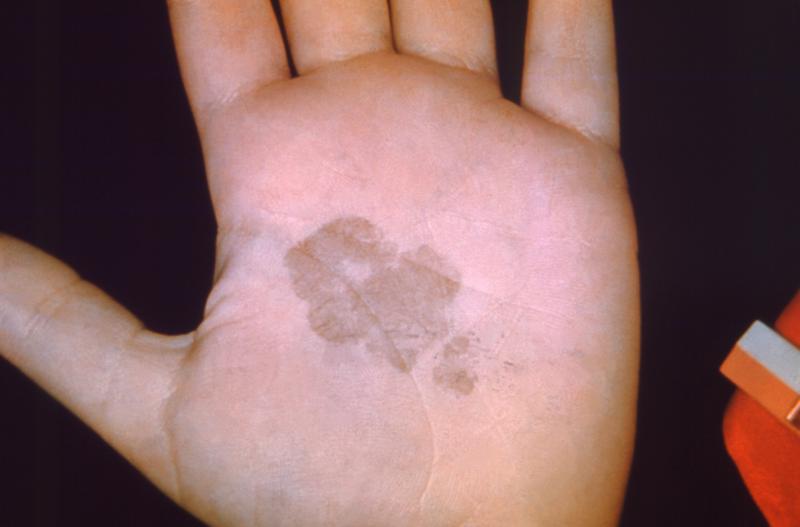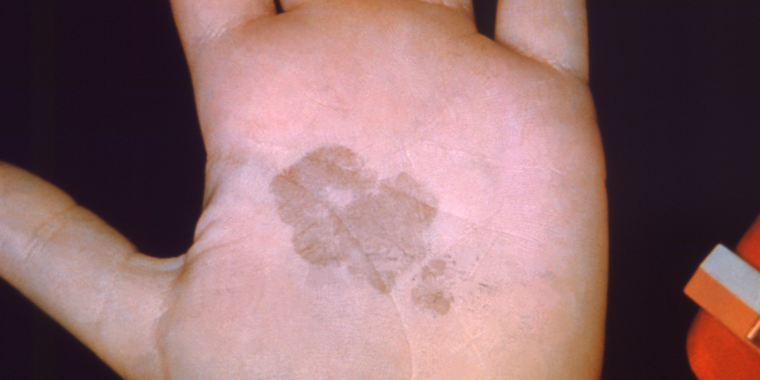
If your palms are a tad sweaty, it might be a good idea to go wash them now, before reading further.
A 19-year-old university student in Philadelphia had a surprising firsthand encounter with rare, tropical black fungus, which was found sprouting into a large, dark circle in the palm of her hand. Her case was reported today in the New England Journal of Medicine.
The dark mark at hand is called tinea nigra, a very uncommon, superficial fungal infection that typically strikes people in humid, tropical, or subtropical coastal areas—and often people in those areas with particularly sweaty palms. The fungus behind nearly all cases is Hortaea werneckii, a warm-dwelling, salt-loving yeast-like fungus that lives in the environment and produces a dark pigment. When grown in petri dishes in labs, H. werneckii forms creamy, stark black yeast-like colonies that eventually become filamentous.

In the rare instances when it greets a welcoming human host, H. werneckii causes a superficial, noninvasive infection in the top layer of skin—the stratum corneum—most often on the palm of the hand, but occasionally on the soles of the feet. Once established, the fungi’s dark hyphae and yeast-like cells fan out in a distinct, but benign dark patch that can unfurl over weeks to months.
The resulting dark spot can look a lot like cancerous conditions, such as melanoma. And because tinea nigra is so rare, melanoma and other non-cancerous skin moles (nevi) may seem more likely explanations. This can result in needless worry and painful biopsies.
When H. werneckii is involved, there’s little to worry about. Most superficial infections are painless and symptomless, except for the growing dark patch. Only rarely do they even cause mild redness or itchiness. The meek mold is more of a mooch than a menace. The most disturbing aspect of the superficial infection might be reports from some patients that their dark marks are darkest in the morning, after a night of fungal flourishing, but then become lighter throughout the day as the mold sloughs off.

To identify H. werneckii, dermatologists can do a quick test called a KOH preparation, which is when a doctor takes a light scrape of skin from the surface, adds potassium hydroxide to dissolve away some of the skin cells, then looks for bits of fungi under a microscope. When H. werneckii is present, it’s easy to spot the brown to blackish hyphae and spores under the scope. And, when it’s time to part ways with the handsy hanger-on, a simple antifungal cream is all that’s needed.
Still, it’s striking to find a case of tinea nigra in Philadelphia, on the hand of a university student with no recent travel. H. werneckii is rare generally, but even rarer in the US. And when cases pop up, they tend to occur in hot, very humid states with coastlines— Texas and Florida in particular, but also California, South Carolina, and North Carolina. The first case ever documented in the US was observed in 1948 in a 15-year-old girl in Florida. Sporadic cases followed in the decades since. In 2020, dermatologists in Houston reported tinea nigra between the toes of a 52-year-old woman. She was treated with Whitfield’s ointment, commonly used to treat athlete’s foot, and the brown spot went away.
However odd the geography, the case in Philadelphia had a common end. Doctors treated the teen with topical butenafine, an over-the-counter antifungal that’s used to treat athlete’s foot and jock itch, among other fungal infections. At a three-month follow-up, her moldy mitt had cleared up.








